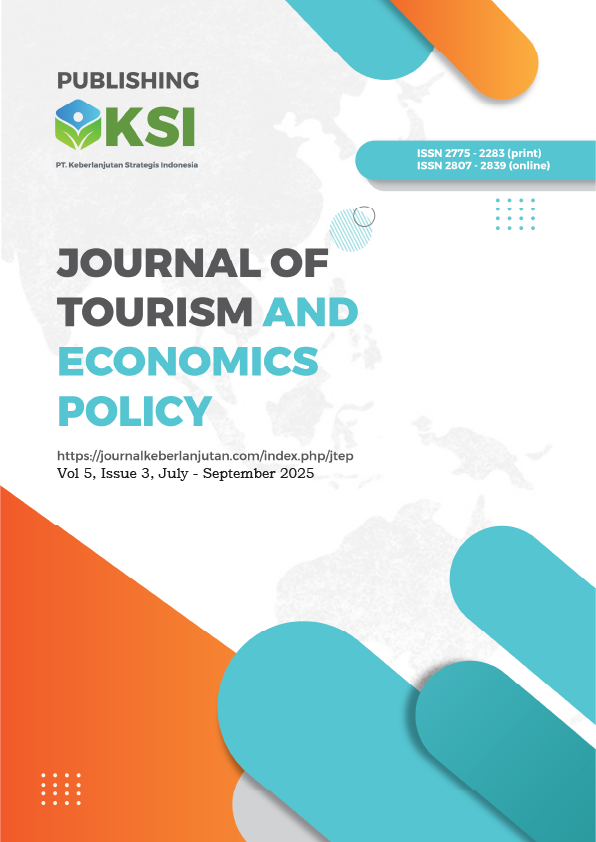Family Visitor Behavior Analysis at Cimory Dairyland on the Valley: a Sustainable Educational Tourism Study
Keywords:
Cimory Dairyland, Educational Tourism, Visitor Behavior, Tourist Satisfaction, Family TourismAbstract
This study analyzes family visitor behavior at Cimory Dairyland On The Valley in Semarang, focusing on visit motivations, behavioral patterns, and visitor satisfaction levels. Employing a qualitative approach with case study methodology, data were collected through in-depth interviews with 20 informants comprising family visitors, destination managers, and educational staff, supplemented by participant observation and document analysis. Results indicate that primary family visit motivations include seeking interactive educational experiences for children (78%), family recreation (65%), and nature interaction (54%). Visitor behavioral patterns demonstrate preferences for educational activities such as petting zoo and milk demonstration, with average visit duration of 4-5 hours. Visitor satisfaction reaches 82% with key factors including educational program quality, facility cleanliness, and staff friendliness. Challenges identified include capacity management during peak seasons, age-specific educational program diversification, and supporting infrastructure development. The study recommends strengthening sustainable educational programs, enhancing visitor management systems, and developing strategic partnerships with educational institutions to establish Dairyland as a premier family educational tourism destination in Central Java.
References
Ajzen, I. (1991). The theory of planned behavior. Organizational Behavior and Human Decision Processes, 50(2), 179-211. https://doi.org/10.1016/0749-5978(91)90020-T
Blichfeldt, B. S., Pedersen, B. M., Johansen, A., & Hansen, L. (2010). Tween tourists: Children and decision-making. Journal of Tourism Consumption and Practice, 2(1), 1-24.
Brady, M. K., & Cronin Jr, J. J. (2001). Some new thoughts on conceptualizing perceived service quality: A hierarchical approach. Journal of Marketing, 65(3), 34-49. https://doi.org/10.1509/jmkg.65.3.34.18334
Carr, N. (2011). Children's and families' holiday experiences. London: Routledge.
Cialdini, R. B. (2007). Influence: The psychology of persuasion. New York: Harper Business.
Cohen, S. A., Prayag, G., & Moital, M. (2014). Consumer behaviour in tourism: Concepts, influences and opportunities. Current Issues in Tourism, 17(10), 872-909. https://doi.org/10.1080/13683500.2013.850064
Creswell, J. W., & Poth, C. N. (2018). Qualitative inquiry and research design: Choosing among five approaches (4th ed.). Thousand Oaks: Sage Publications.
Crompton, J. L. (1979). Motivations for pleasure vacation. Annals of Tourism Research, 6(4), 408-424. https://doi.org/10.1016/0160-7383(79)90004-5
Falk, J. H., Ballantyne, R., Packer, J., & Benckendorff, P. (2012). Travel and learning: A neglected tourism research area. Annals of Tourism Research, 39(2), 908-927. https://doi.org/10.1016/j.annals.2011.11.016
Goodwin, H., & Santilli, R. (2009). Community-based tourism: A success? ICRT Occasional Paper, 11, 1-37. Retrieved from https://www.icrtourism.org/wp-content/uploads/2012/03/OP11.pdf
Johns, N., & Gyimothy, S. (2002). Market segmentation and the prediction of tourist behavior: The case of Bornholm, Denmark. Journal of Travel Research, 40(3), 316-327. https://doi.org/10.1177/0047287502040003009
Kolb, D. A. (1984). Experiential learning: Experience as the source of learning and development. Englewood Cliffs: Prentice-Hall.
Mengku Marhendi, P. A. (2022). Community-based tourism development in Central Java region: A study of community-based tourism implementation. Gemawisata: Journal of Tourism Science, 18(2), 145-162.
Mengku Marhendi, P. A. (2023). Tourist perception and behavior toward tourism attractions in Central Java: Analysis of quality factors and visitor satisfaction. Nawasena: Journal of Tourism Science, 2(3), 78-95.
Mengku Marhendi, P. A. (2024). Community and tourist image of tourism attractions in Semarang City. Gemawisata: Journal of Tourism Science, 21(1), 33-49. https://doi.org/10.56910/gemawisata.v21i1.388
Moscardo, G. (1996). Mindful visitors: Heritage and tourism. Annals of Tourism Research, 23(2), 376-397. https://doi.org/10.1016/0160-7383(95)00068-2
Neuhofer, B., Buhalis, D., & Ladkin, A. (2012). Conceptualising technology enhanced destination experiences. Journal of Destination Marketing & Management, 1(1-2), 36-46. https://doi.org/10.1016/j.jdmm.2012.08.001
Oliver, R. L. (2010). Satisfaction: A behavioral perspective on the consumer (2nd ed.). Armonk: M.E. Sharpe.
Packer, J., & Ballantyne, R. (2016). Conceptualizing the visitor experience: A review of literature and development of a multifaceted model. Visitor Studies, 19(2), 128-143. https://doi.org/10.1080/10645578.2016.1144023
Parasuraman, A., Zeithaml, V. A., & Berry, L. L. (1988). SERVQUAL: A multiple-item scale for measuring consumer perceptions of service quality. Journal of Retailing, 64(1), 12-40.
Phillimore, J., & Goodson, L. (2004). Qualitative research in tourism: Ontologies, epistemologies and methodologies. London: Routledge.
Pine, B. J., & Gilmore, J. H. (1999). The experience economy: Work is theatre & every business a stage. Boston: Harvard Business Review Press.
Pranoto. (2022). Educational-based village tourism development: Integrated learning model for sustainable family tourism. Visi Manajemen, 7(2), 89-105.
Pranoto. (2024). Sustainable village tourism development strategy: Community-based tourism approach to enhance tourist satisfaction. Nawasena: Journal of Tourism Science, 3(1), 112-128.
Pranoto, Dimyati, & Suhadi. (2023). Village institutional strengthening in urban farming champion event and community service month in Kalisegoro Village, Gunungpati District, Semarang City. Journal of Community Service, 1(9), 234-248. https://doi.org/10.31219/osf.io/x7v2m
Ritchie, B. W., Carr, N., & Cooper, C. P. (2003). Managing educational tourism. Clevedon: Channel View Publications.
Stake, R. E. (1995). The art of case study research. Thousand Oaks: Sage Publications.
United Nations World Tourism Organization. (2013). Sustainable tourism for development guidebook. Madrid: UNWTO. Retrieved from https://www.unwto.org/sustainable-development
Wang, D., Li, X. R., & Li, Y. (2016). China's "smart tourism destination" initiative: A taste of the service-dominant logic. Journal of Destination Marketing & Management, 2(2), 59-61. https://doi.org/10.1016/j.jdmm.2013.05.004
Xiang, Z., & Gretzel, U. (2010). Role of social media in online travel information search. Tourism Management, 31(2), 179-188. https://doi.org/10.1016/j.tourman.2009.02.016
Downloads
Published
Issue
Section
License
Copyright (c) 2025 Monica MONICA, Mengku MARHENDI

This work is licensed under a Creative Commons Attribution-NonCommercial 4.0 International License.
Creative Commons Attribution-NonCommercial 4.0 International License.





















